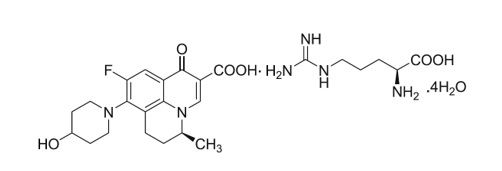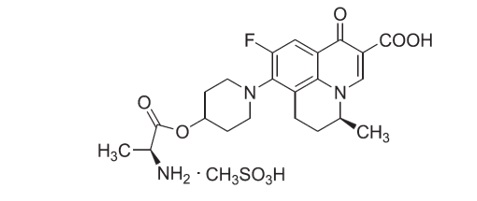- Thrombocytopenia and bone marrow suppression
- Lactic acidosis
- Serotonin syndrome
- Peripheral and ocular neuropathies
- Not indicated for MRSA bacteraemia and endocarditis
- Not preferred in cancer/neutropenic patients due to bacteriostatic nature
- On-therapy safety monitoring required
- Inter-patient pharmacokinetic variability
- Acute bacterial skin and skin structure infections (ABSSSI) and concurrent bacteraemia
- Diabetic-foot infections.


- EMROK: 800 mg every 12 hours by intravenous (IV) infusion over a period of 90 minutes
- EMROK O: 1000 mg (two tablets of 500 mg each) every 12 hours
EMROK demonstrates bactericidal activity through dual inhibition of DNA gyrase and topoisomerase IV with DNA gyrase being the primary target. Due to primacy towards DNA gyrase, EMROK causes rapid bactericidal action with minimal propensity for resistance development.
Yes. The unique 4-hydroxy piperidine side chain at C-8 position of the benzoquinolizine core and anionic nature imparts EMROK with an increased activity under acidic conditions which could be clinically beneficial in pus, abscess, wounds and biofilms.
- Gram-positive: MRSA/quinolone-resistant S. aureus (QRSA), VISA, hetero-VISA, VRSA, linezolid-non-susceptible S. aureus, macrolide & penicillin-resistant Streptococcus, vancomycin-resistant E. faecalis and vancomycin-susceptible E. faecium
- Community respiratory Gram-negative pathogens: Haemophilus in¬fluenzae, and Moraxella catarrhalis
- Atypical respiratory pathogens – Mycoplasma spp., Ureaplasma spp., Chlamydia spp., and Legionella spp.
- Anaerobes- Bacteroids spp., Prevotella spp., and Clostridium sp
- Susceptible Gram-negative pathogens: E. coli, K. pneumoniae, Enterobacter spp., Citrobacter spp., Pseudomonas aeruginosa, Stenotrophomonas maltophilia, Burkholderia species and Acinetobacter baumannii
- Primary targeting DNA Gyrase, a highly critical enzyme for cell survival
- Potent activity even against mutated targets thus overcoming quinolone resistance in MRSA
- Narrow mutant selection window
- Rapid and high density bacterial killing
- MRSA biofilm eradication potential
No. EMROK IV and EMROK O doses are not calculated based on body weight. Thus, the dose adjustment is generally not required for underweight or overweight patients.
- Vancomycin (IV)
- Linezolid (IV and oral)
- Teicoplanin (IV)
- Daptomycin (IV)
- Clindamycin (Oral)
- Trimethoprim/Sulfamethoxazole (Oral)
- Bone and joint infections
- Diabetic-foot infections
- Catheter-related blood stream infections
- Prosthetic-joint infections
- Device-associated infections
- Community-acquired bacterial pneumonia
- Bone and joint infections including prosthetic joint infections
- Febrile neutropenia
- Device/catheter-associated infections
- Sepsis
- Inconsistent coverage of MRSA
- No bactericidal activity
- Nearly 45% of MRSA exhibit inducible erm-mediated resistance to clindamycin which could be missed if D test is not performed. These isolates select resistance to clindamycin during therapy
- Narrow spectrum (no coverage of Gram-negatives)
- Unproven efficacy for the treatment of invasive MRSA infections
- Antibiotic-associated diarrhoea
EMROK has a unique lipophilic tricyclic benzoquinolizine core which provides it with better bacterial cell permeation, enhanced target affinity and ability to overcome efflux pumps in MRSA. Since EMROK is not a substrate of efflux pumps, this helps attain higher intracellular concentrations (unlike ciprofloxacin, norfloxacin) leading to lower potential to select resistance. EMROK has an anionic nature which enables further enhanced bactericidal action against both Gram-positive and Gram-negative pathogens under acidic conditions. Moreover, in non-clinical, clinical studies and post-marketing experience, EMROK has demonstrated a remarkable safety with negligible adverse effects.
Phase III study has been successfully completed across 40 centres in India with a total of 501 adults being recruited with clinically documented ABSSSI. EMROK (800 mg) and EMROK O (1000 mg) were compared with I.V. Linezolid (600 mg) and oral Linezolid (600 mg), respectively.
EMROK immunomodulatory activity was assessed through ex-vivo study by treating human whole blood with lipopolysaccharide (LPS) and also through in vivo studies by injecting LPS to rat and mice. In all of these studies, EMROK showed significant suppression in the levels of pro-inflammatory cytokines like TNF-α, IL-6 and IL-1β. Further in mice, wherein LPS was treated intra-nasally to develop acute lung injury, EMROK showed significant reduction in lung injury which was evident through histopathological observations. The significant reduction in pro-inflammatory cytokine levels by EMROK was depictive of its immunomodulatory effect. However, EMROK should not be used as a treatment for anti-inflammatory effect.
- Community-acquired bacterial pneumonia (CABP)
- Hospital- and ventilator-associated bacterial pneumonia (HABP/VABP)
- Catheter-related blood stream infections (CR-BSI)
- Complicated skin and soft tissue infections (SSTIs)
- Febrile neutropenia
- Best-in-class lung concentrations (7.6 times higher than plasma) that remain higher than the MIC90 of MRSA and all the community-respiratory pathogens throughout the dosing duration
- High potency against MRSA and all the multi-drug resistant community respiratory pathogens
- Higher intracellular concentration in alveolar macrophages favouring activity against intracellular pathogens like MRSA and atypical respiratory pathogens
- Potent bactericidal action
- Anti-inflammatory activity as demonstrated from in vivo and ex vivo models
In the Phase III study, the most common adverse event related to EMROK and EMROK O treatment was constipation (3.6%) of mild intensity.
The study was designed for a non-inferiority margin of -15%. However, the clinical cure rates (efficacy end point) observed for EMROK or EMROK O at the test-of-cure were numerically higher compared to linezolid IV and oral, respectively. The treatment difference between EMROK and linezolid in IV group at 95% CI was -4.5 to 10.9% (91.0% versus 87.8%) and in the oral group, the difference was -4.2 to 7.3% (95.2% versus 93.6%). Thus, the actual results demonstrated non-inferiority at > -5%.
A large multi-center, retrospective, post-marketing, real-world, observational study (PIONEER study) was conducted for assessment of safety and efficacy of EMROK and EMROK O in treating various bacterial infections. The data of 1299 patients from 117 hospitals across India was collected. Data of 1229 patients who received treatment for various bacterial infections was collected. EMROK and EMROK O showed very high efficacy and received remarkable safety ratings from the clinicians in this study. Both the agents were successfully used for the treatment of several indications such as ABSSI, pneumonia, COVID19 secondary bacterial pneumonia, BJIs, febrile neutropenia, CR-BSI, septicaemia etc. The clinical success rates were up to 96.8%.
None. In the Pioneer study, out of 1229 patients, none experienced EMROK/EMROK O-linked serious adverse events. Only 9 patients reported adverse events which were mild intensity of nausea, vomiting, constipation.
- Acute bacterial skin and skin structure infection (ABSSSI)
- Diabetic-foot infection (DFI)
- Community-acquired bacterial pneumonia (CABP)
- Bone and joint infection (BJI)
- Device/catheter-associated infection
- Blood stream infection (BSI)
- Hospital- and ventilator-associated bacterial pneumonia (HABP/VABP)
- Endocarditis
- Burns
There is no clinical experience of using EMROK/EMROK O in patients with tendon disorders. Even though EMROK/EMROK O belongs to benzoquinolizine sub-class of fluoroquinolone, owing to certain common moieties in the structure, EMROK/EMROK O may not be preferred in patients with tendon disorders. However, in clinical studies and post marketing real-world observations, EMROK has not been reported to cause tendon disorders even when administered in older patients. Moreover, owing to the previously known class effect of quinolones interaction corticosteroids, EMROK should not be administered in concomitance with steroids. However, in real world use of EMROK, no such clinical incidence of drug-drug interaction has been reported.
Due to feasibility challenges, concentrations of EMROK in human bones were not estimated. However, a surrogate marker, bone penetration study was conducted in rats. The bone penetration of EMROK relative to plasma was 5x. It means that the concentration of EMROK in bones remained above MIC90 for MDR Gram-positive pathogens including MRSA throughout the dosing interval. Moreover, in vitro and in vivo studies have shown the activity of EMROK against Staphylococcus biofilms. This is a crucial and enabling feature in treating bone and joint infections wherein involvement of biofilms is common. In a translational biofilm model study in mice, conducted at University of North Texas, at therapeutic exposures, EMROK killed biofilm embedded S. aureus better than that of rifampicin. Thus excellent bone penetration coupled with activity against biofilms augurs well for EMROK to be a choice of treatment for bone and joint infections

